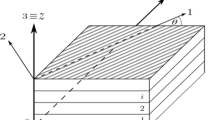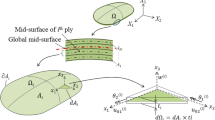Abstract
In this paper, a procedure for optimizing the fiber orientations near a hole in a single layer of multilayer composite laminates for increased strength is presented. A symmetric six-layer [(C-0)/+45/-45]s laminate with central hole is considered. Within the ±45° layers, the fiber orientations are fixed. The C-0 layer is divided into two fields: a small near field around the hole and a relatively large far field away from the hole. In the far field, the fiber orientations are fixed at 0°, and in the near field, the fiber orientations are assumed to have continuous distribution represented by piecewise bilinear interpolation functions. The Tsai–Wu-criterion-based failure load magnitudes of [(C-0)/+45/-45]s and [C-0]6 designs are maximized by iteratively alternating between a gradient-based search and a genetic algorithm. The results show that the load-carrying capacity of composite laminates with hole can be greatly increased through the optimization of continuous fiber orientation distribution within a small area around the hole in the C-0 layer, and the optimum fiber orientation distribution pattern in the C-0 layer is similar to that of the corresponding principal stress orientation distribution. The [(C-0)/+45/-45]s design is only a few percent weaker than the [C-0]6 design, which is important for carrying off-design loadings.
Similar content being viewed by others
References
7 Gunderson SL, Lute JA (1993) The use of preformed holes for increased strength and damage tolerance of advanced composites. J Reinf Plast Comp 12:(5)559–569
8 Huang J, Haftka RT, Rapoff RJ (2003) Optimization design of composite plates with holes for increased strength. In: Proceed-ings of the 44th AIAA/ASME/ASCE/AHS/ASC conference on structures, structural dynamics, and materials, Norfolk, VA
12 Huang J, Venkataraman S, Rapoff RJ, Haftka RT (2003) Optimization of axisymmetric elastic modulus distributions around a hole for increased strength. J Struct Multidisc Optim 25(4):225–236
3 Hyer MW, Charette RF (1991) Use of curvilinear fiber format in composite structure design. AIAA J 29(6):1011–1015
4 Hyer MW, Lee HH (1991) The use of curvilinear fiber format to improve buckling resistance of composite plates with central circular holes. Comp Struct 18:239–261
1 Jegley DC, Tatting BF, Gürdal Z (2003) Optimization of elastically tailored tow-placed plates with holes. In: Proceedings of the 44th AIAA/ASME/ASCE/AHS/ASC conference on structures, structural dynamics, and materials, Norfolk, VA
2 Katz Y, Haftka RT, Altus E (1989) Optimization of fiber directions for increasing the failure load of a plate with a hole. In: Proceedings of the ASC 4th technical conference on composite materials, Blacksburg, VA, 3–5 October 1989
5 Nagendra S, Kodiyalam S, Davis JE (1995) Optimization of tow fiber paths for composite design. In: Proceedings of the 36th AIAA/ASME/ASCE/AHS/ASC conference on structures, structural dynamics, and materials and AIAA/ASME forum on adaptive structures, New Orleans, LA
6 Parnas L, Oral S, Ceyhan Ü (2003) Optimum design of composite structures with curved fiber courses. J Comp Sci Tech 63:1071–1082
10 Vanderplaats, Miura & Associates (1993) DOT user’s manual, Colorado Springs, CO
11 Wall M (2003) GAlib: A C++ library of genetic algorithm components, version 2.4.5. Freeware available at http://lancet.mit.edu/ga/[accessed 8 May 2003]
9 Yau SS, Chou TW (1988) Strength of woven-fabric composites with drilled and molded holes. Composite Materials Testing and Design, ASTM STP972, American Society for Testing and Materials, Philadelphia, pp 423–437
Author information
Authors and Affiliations
Corresponding author
Rights and permissions
About this article
Cite this article
Huang, J., Haftka, R. Optimization of fiber orientations near a hole for increased load-carrying capacity of composite laminates. Struct Multidisc Optim 30, 335–341 (2005). https://doi.org/10.1007/s00158-005-0519-z
Received:
Revised:
Published:
Issue Date:
DOI: https://doi.org/10.1007/s00158-005-0519-z




